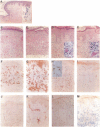Abstract
We developed a chimeric human-severe combined immunodeficient mouse model to study human allograft rejection. Mice received first partial thickness human skin grafts and then, after anastomosis of the mouse with graft human microvessels, human lymphocytes allogeneic to the skin. By 2 weeks, the skin grafts uniformly developed changes that resemble first-set skin rejection in humans. Vascular cell adhesion molecule 1 and major histocompatibility complex class II molecules were induced on the human vascular endothelium at day 6, prior to significant T-cell infiltration. Perivascular human CD4+ and CD8+ T-cell infiltrates were marked by day 11. Some T cells, adjacent to injured human vessels, expressed the cytolytic granule protein perforin. The human microvessels were destroyed by day 16 without significant damage to human keratinocytes or adjacent mouse microvessels. This small animal model may permit evaluation of potential therapeutic reagents that inhibit human T-cell-mediated injury.
Full text
PDF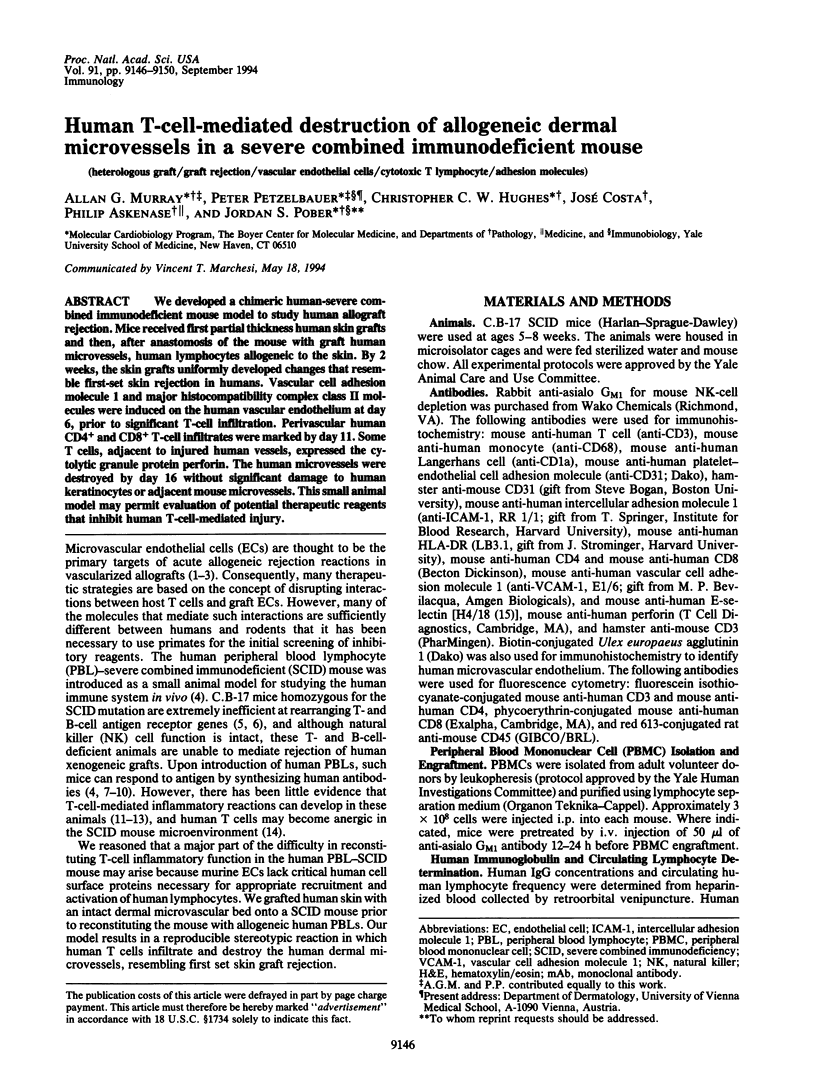
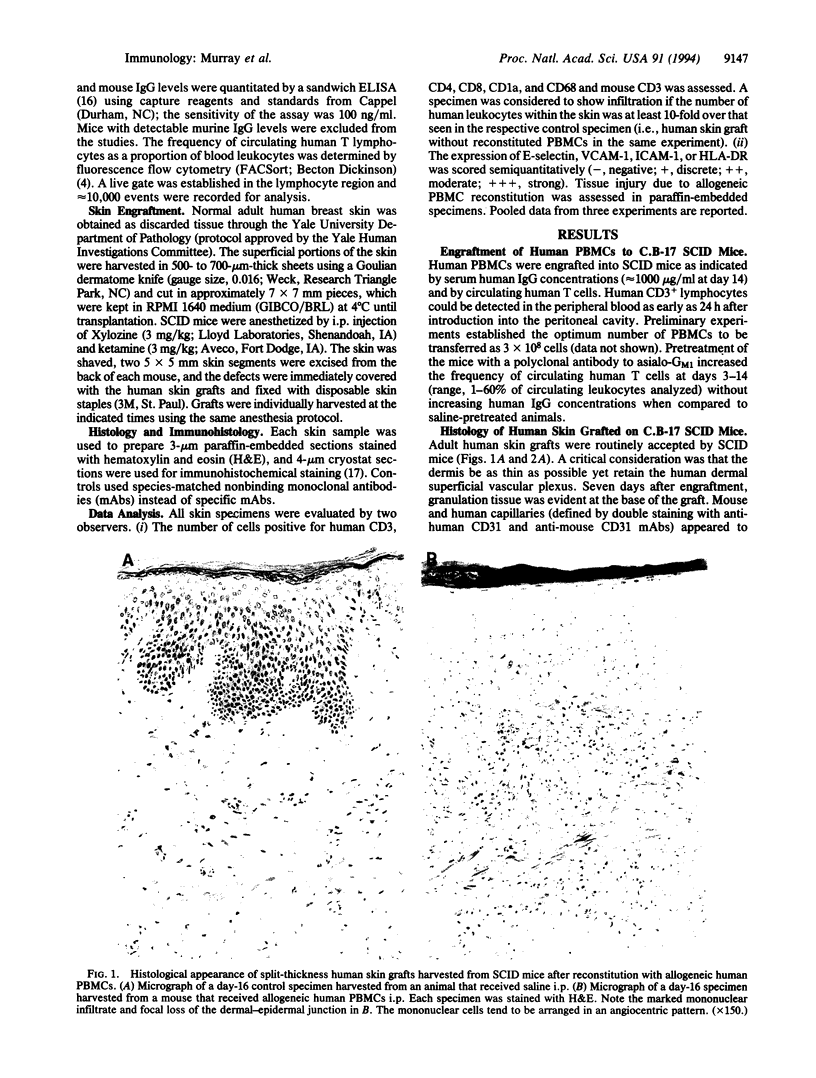
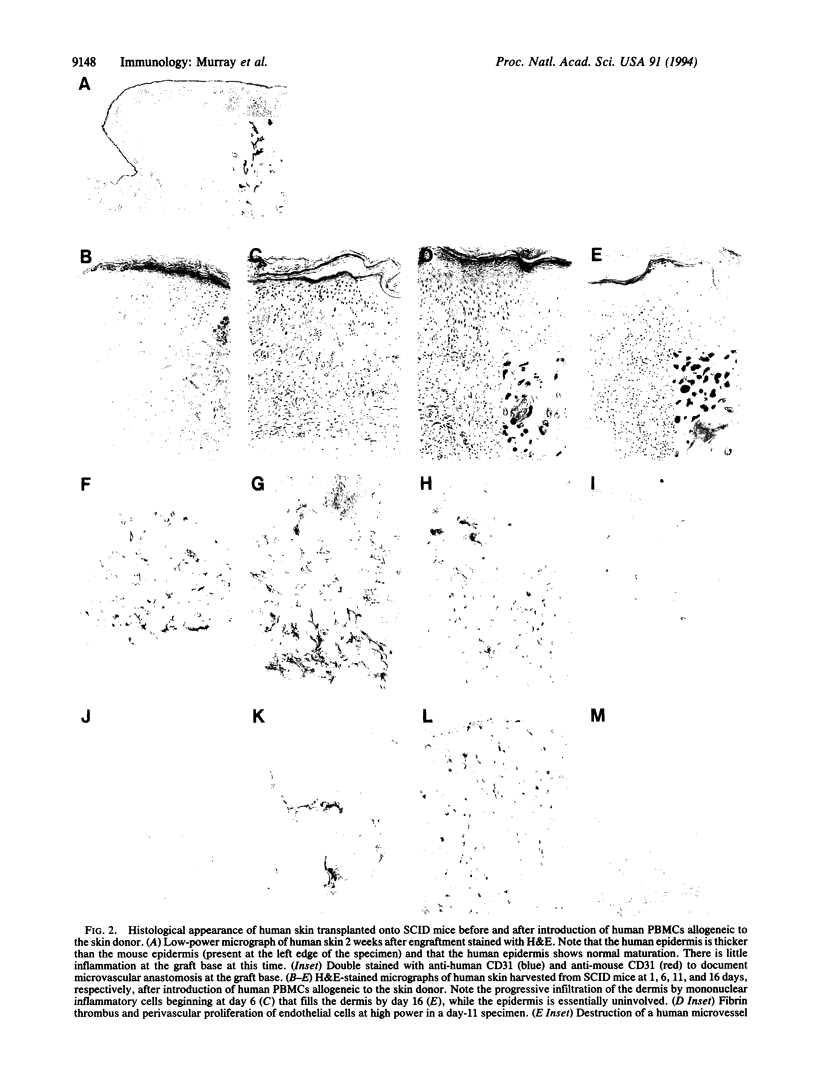
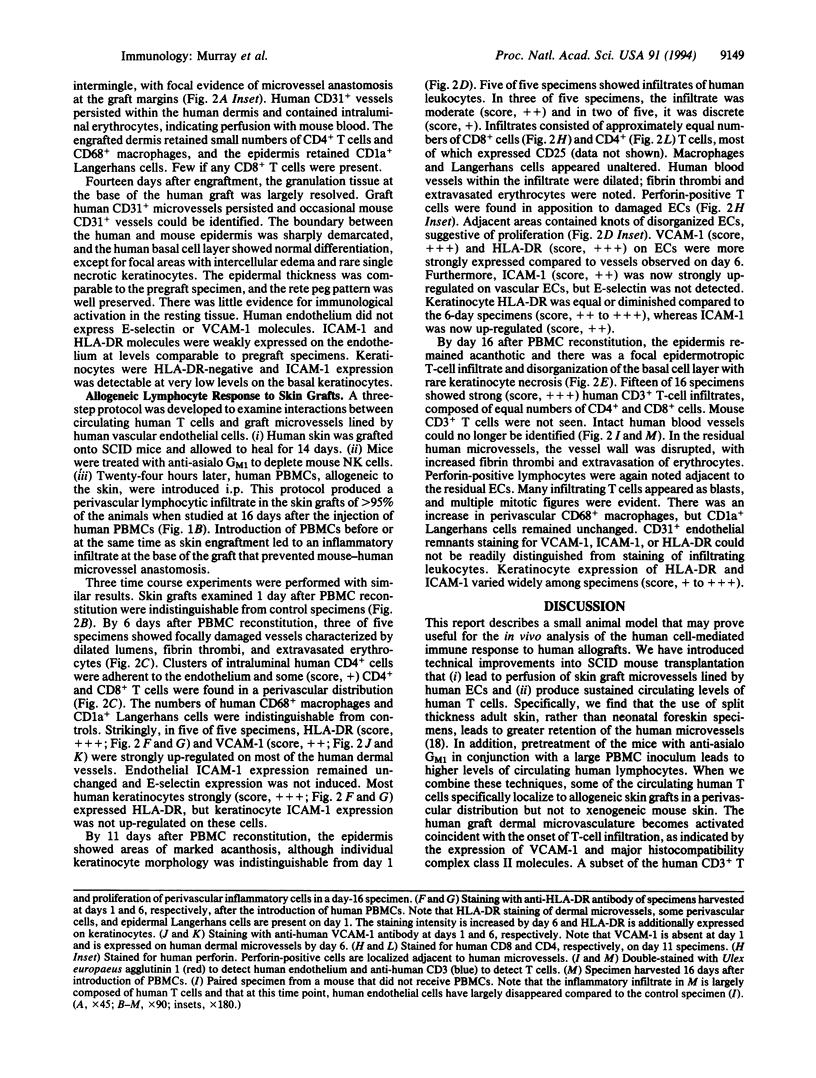
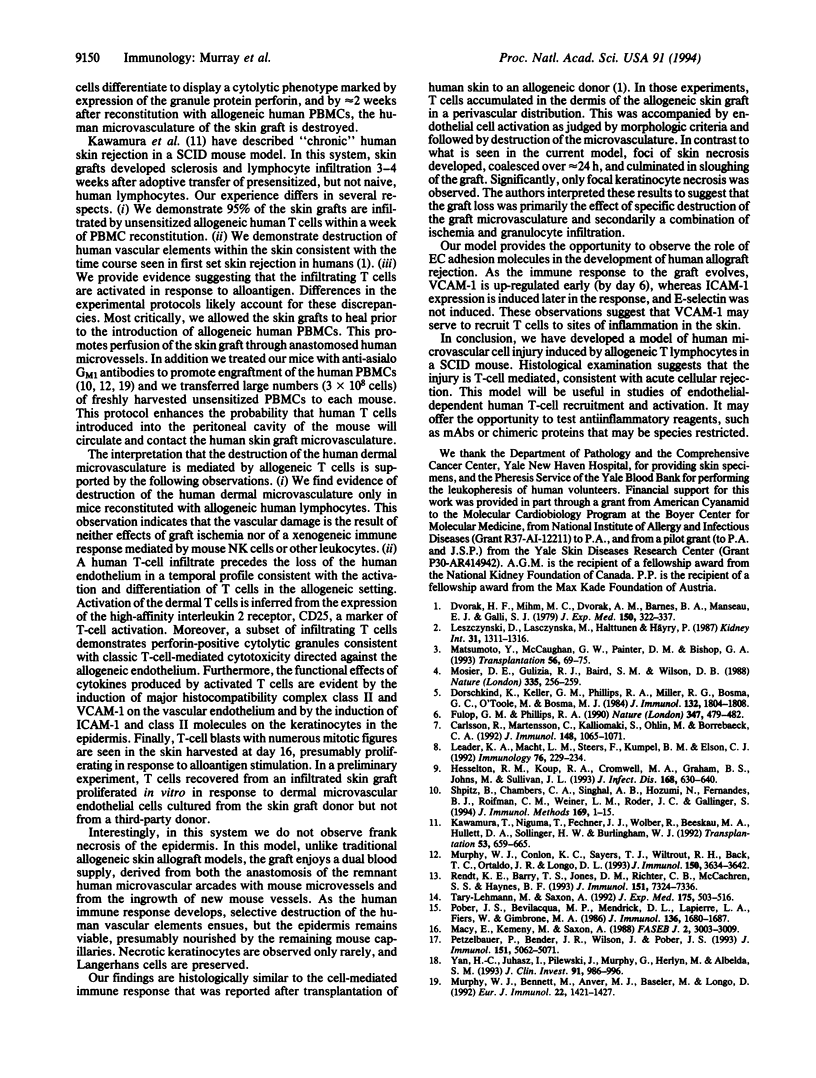
Images in this article
Selected References
These references are in PubMed. This may not be the complete list of references from this article.
- Carlsson R., Mårtensson C., Kalliomäki S., Ohlin M., Borrebaeck C. A. Human peripheral blood lymphocytes transplanted into SCID mice constitute an in vivo culture system exhibiting several parameters found in a normal humoral immune response and are a source of immunocytes for the production of human monoclonal antibodies. J Immunol. 1992 Feb 15;148(4):1065–1071. [PubMed] [Google Scholar]
- Dorshkind K., Keller G. M., Phillips R. A., Miller R. G., Bosma G. C., O'Toole M., Bosma M. J. Functional status of cells from lymphoid and myeloid tissues in mice with severe combined immunodeficiency disease. J Immunol. 1984 Apr;132(4):1804–1808. [PubMed] [Google Scholar]
- Dvorak H. F., Mihm M. C., Jr, Dvorak A. M., Barnes B. A., Manseau E. J., Galli S. J. Rejection of first-set skin allografts in man. the microvasculature is the critical target of the immune response. J Exp Med. 1979 Aug 1;150(2):322–337. doi: 10.1084/jem.150.2.322. [DOI] [PMC free article] [PubMed] [Google Scholar]
- Fulop G. M., Phillips R. A. The scid mutation in mice causes a general defect in DNA repair. Nature. 1990 Oct 4;347(6292):479–482. doi: 10.1038/347479a0. [DOI] [PubMed] [Google Scholar]
- Hesselton R. M., Koup R. A., Cromwell M. A., Graham B. S., Johns M., Sullivan J. L. Human peripheral blood xenografts in the SCID mouse: characterization of immunologic reconstitution. J Infect Dis. 1993 Sep;168(3):630–640. doi: 10.1093/infdis/168.3.630. [DOI] [PubMed] [Google Scholar]
- Kawamura T., Niguma T., Fechner J. H., Jr, Wolber R., Beeskau M. A., Hullett D. A., Sollinger H. W., Burlingham W. J. Chronic human skin graft rejection in severe combined immunodeficient mice engrafted with human PBL from an HLA-presensitized donor. Transplantation. 1992 Mar;53(3):659–665. doi: 10.1097/00007890-199203000-00032. [DOI] [PubMed] [Google Scholar]
- Leader K. A., Macht L. M., Steers F., Kumpel B. M., Elson C. J. Antibody responses to the blood group antigen D in SCID mice reconstituted with human blood mononuclear cells. Immunology. 1992 Jun;76(2):229–234. [PMC free article] [PubMed] [Google Scholar]
- Leszczynski D., Laszczynska M., Halttunen J., Häyry P. Renal target structures in acute allograft rejection: a histochemical study. Kidney Int. 1987 Jun;31(6):1311–1316. doi: 10.1038/ki.1987.144. [DOI] [PubMed] [Google Scholar]
- Macy E., Kemeny M., Saxon A. Enhanced ELISA: how to measure less than 10 picograms of a specific protein (immunoglobulin) in less than 8 hours. FASEB J. 1988 Nov;2(14):3003–3009. doi: 10.1096/fasebj.2.14.3263291. [DOI] [PubMed] [Google Scholar]
- Matsumoto Y., McCaughan G. W., Painter D. M., Bishop G. A. Evidence that portal tract microvascular destruction precedes bile duct loss in human liver allograft rejection. Transplantation. 1993 Jul;56(1):69–75. doi: 10.1097/00007890-199307000-00012. [DOI] [PubMed] [Google Scholar]
- Mosier D. E., Gulizia R. J., Baird S. M., Wilson D. B. Transfer of a functional human immune system to mice with severe combined immunodeficiency. Nature. 1988 Sep 15;335(6187):256–259. doi: 10.1038/335256a0. [DOI] [PubMed] [Google Scholar]
- Murphy W. J., Bennett M., Anver M. R., Baseler M., Longo D. L. Human-mouse lymphoid chimeras: host-vs.-graft and graft-vs.-host reactions. Eur J Immunol. 1992 Jun;22(6):1421–1427. doi: 10.1002/eji.1830220614. [DOI] [PubMed] [Google Scholar]
- Murphy W. J., Conlon K. C., Sayers T. J., Wiltrout R. H., Back T. C., Ortaldo J. R., Longo D. L. Engraftment and activity of anti-CD3-activated human peripheral blood lymphocytes transferred into mice with severe combined immune deficiency. J Immunol. 1993 Apr 15;150(8 Pt 1):3634–3642. [PubMed] [Google Scholar]
- Petzelbauer P., Bender J. R., Wilson J., Pober J. S. Heterogeneity of dermal microvascular endothelial cell antigen expression and cytokine responsiveness in situ and in cell culture. J Immunol. 1993 Nov 1;151(9):5062–5072. [PubMed] [Google Scholar]
- Pober J. S., Bevilacqua M. P., Mendrick D. L., Lapierre L. A., Fiers W., Gimbrone M. A., Jr Two distinct monokines, interleukin 1 and tumor necrosis factor, each independently induce biosynthesis and transient expression of the same antigen on the surface of cultured human vascular endothelial cells. J Immunol. 1986 Mar 1;136(5):1680–1687. [PubMed] [Google Scholar]
- Rendt K. E., Barry T. S., Jones D. M., Richter C. B., McCachren S. S., Haynes B. F. Engraftment of human synovium into severe combined immune deficient mice. Migration of human peripheral blood T cells to engrafted human synovium and to mouse lymph nodes. J Immunol. 1993 Dec 15;151(12):7324–7336. [PubMed] [Google Scholar]
- Shpitz B., Chambers C. A., Singhal A. B., Hozumi N., Fernandes B. J., Roifman C. M., Weiner L. M., Roder J. C., Gallinger S. High level functional engraftment of severe combined immunodeficient mice with human peripheral blood lymphocytes following pretreatment with radiation and anti-asialo GM1. J Immunol Methods. 1994 Feb 28;169(1):1–15. doi: 10.1016/0022-1759(94)90119-8. [DOI] [PubMed] [Google Scholar]
- Tary-Lehmann M., Saxon A. Human mature T cells that are anergic in vivo prevail in SCID mice reconstituted with human peripheral blood. J Exp Med. 1992 Feb 1;175(2):503–516. doi: 10.1084/jem.175.2.503. [DOI] [PMC free article] [PubMed] [Google Scholar]
- Yan H. C., Juhasz I., Pilewski J., Murphy G. F., Herlyn M., Albelda S. M. Human/severe combined immunodeficient mouse chimeras. An experimental in vivo model system to study the regulation of human endothelial cell-leukocyte adhesion molecules. J Clin Invest. 1993 Mar;91(3):986–996. doi: 10.1172/JCI116320. [DOI] [PMC free article] [PubMed] [Google Scholar]




